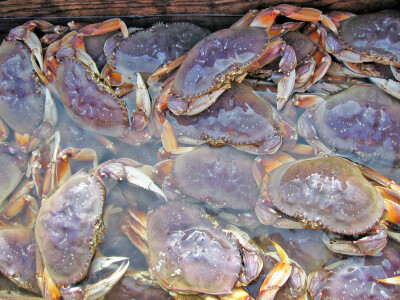Alaska and Pacific Blackcod and Halibut
Weaker yen wears on blackcod price; as halibut quota dips, so does demand
As the new season began March 23, blackcod fishermen found ex-vessel prices substantially lower than in 2012, thanks to the Japanese yen's declining value.
According to Bob Alverson, the Seattle-based Fishing Vessel Owners' Association's general manager, deliveries of blackcod, 7 pounds and up, fetched $5.25. That's substantially less than the $8.50 per pound processors paid last year. Alverson and others blame lower prices on a weakening yen.
The yen's monthly value averaged 97.7 to the dollar in April, the weakest exchange rate registered since May 2009 (96.6). In April last year it traded at 81.4 to the dollar.
"Basically, they have 23 percent less purchasing power," Alverson says, "so the price is going to drop."
Additionally, some distributors who made purchases during last year's season got saddled with carryover inventories going into this season, says Kevin Hogan, owner and president of the Auction Block, in Homer, Alaska.
"The stuff's not moving," Hogan says. "Some folks are sitting on product."
And when product does move, some of it has sold for drastically reduced prices in Japan, says Scott Adams, operations and production manager with Hallmark Fisheries in Charleston, Ore. But Adams says there may be a silver lining.
"We don't have any demand from Japan or Hawaii, but if there's a bright spot, the fresh domestic market has grown," he says.
Adams says he's fielding more calls from hotels and restaurants seeking the larger fish because they're selling fillets.
"One of the things I've seen growing is the fillet market," Adams says. "It's a good market."
This year's blackcod TAC is 28 million pounds, slightly less than 2012's 29 million pounds. Blackcod ex-vessel prices for fish delivered to Homer on April 24 were $2 per pound for fish weighing between 2 and 3 pounds, $3.50 for 3- to 4-pounders, $4 for 4- to 5-pounders, $5 for 5 to 7 pounders and $6 for 7-ups.
Halibut longliners, meanwhile, have enjoyed an ex-vessel price surge that's corresponded with lower quotas in recent years. But observers say a reduced halibut quota won't foster higher ex-vessel prices this year.
The 2013 quota of 21.9 million pounds has slipped from 2012's 25.5 million pounds and 2011's 30.4 million pounds.
Halibut ex-vessel prices in May stood at $5.35 to $5.90 per pound for 10-pounders to 40-ups. That's down slightly from the range of $5.65 to $6.56 seen last May. Prices peaked at $7.10 late last summer.
Meanwhile, Alverson says retail market prices may have reached the maximum consumers will pay for a slab of the coveted flatfish.
"We had less supply," Alverson says. "But the market got overheated."
Halibut fillets filling Alaska seafood display cases this year cost $18 per pound. Alverson says he's seen similar prices in Seattle, save for markets catering to wealthier customers where prices reached $22 per pound. Last year, flatty fillets commanded $24 to $25 in markets.
Restaurant reaction to a reduced supply, Alverson adds, may mean fewer offerings for diners. Where he observed three or four halibut-powered dishes on menus last year, Alverson says he now sees just one.
Moreover, processors eager to build up frozen inventories after last year's season ended got stuck with surplus product when retail consumers and restaurants began pulling back. Consequently, they had cold storage holdings when this year's season began.
"Some guys got a lot more into it than they can sell it for," Hogan says. "There's a fair amount of resistance to the prices in the retail market."
— Charlie Ess
Northeast Scallops
Industry willing to trade quota cuts today for a bumper crop in two years
Substantial reductions in the 2013-14 allowable catch limits will likely keep prices steady in the East Coast scallop fishery, one of very few that withstood the black-hole gravity of the recession.
Crewmen will get fewer trips thanks to cutbacks that average 35 percent of recent quotas across the fleet. But after a run of good years, sentiment in the industry favors waiting the two or three years that scientists say it will take for a new crop of Mid-Atlantic scallops to grow.
Biomass predictions, area rotation and conservation imperatives led the New England Fishery Management Council to lower allowable catch limits for the fleet by about one-third for the next two fishing years.
Still the United States has by far the most productive Atlantic scallop fishery.
In April, prices across the board for Mid-Atlantic and New England scallops hovered around $11 a pound for most sizes, and over $12 a pound for the freshest and largest U-10 and U-12 day-boat scallops.
Retail prices of $16 to $18 at fish counters don't deter a loyal customer base, built up in recent years by the food media's popularization of fresh scallops and broader supply of quality product.
Scallop prices generally jumped 20 percent from fall 2010 into 2011, according to NMFS data, and they've stayed there. Those prices are probably as high as the market can handle, says longtime industry advocate Jim Kendall of New Bedford Seafood Consulting.
"I don't know how much the consumer can absorb in price increases. A lot will depend on how the economy is rebuilding," Kendall says.
Years ago prices for scallops in the marketplace were closely tied to those for fresh U.S. shrimp. But the glut of cheap imported frozen shrimp and wider availability of high-quality American scallops broke that connection. Still, Kendall says, "I would not want to see it become a specialty item like caviar."
The quota cut could actually help Japanese imports to the U.S. West Coast. That market dried up after 2011's earthquake, tsunami and Fukushima Daiichi reactor disaster in Japan, which led to dramatic Asian demand for U.S. scallops.
But now Japan's scallop industry is rebounding strongly. Its exports doubled last year to 4,000 metric tons, according to the United Nations Food and Agriculture Organization.
And Japan's Hokkaido Federation of Fisheries Cooperative Association's scallop fishery gained Marine Stewardship Council certification in May. That will enable the Japanese product to carry MSC's blue ecolabel.
Independent findings from researchers at the School for Marine Science and Technology at the University of Massachusetts, Dartmouth, back up government forecasting. SMAST reported the numbers of young scallops recruiting to the stock in 2012, especially in the Mid-Atlantic, was the biggest since 2001. Back then, big spawning events reversed the scallop industry's fortunes, setting the stage for a prosperous decade.
The SMAST report was a big confidence-builder for the industry and most fishermen are accepting of the lower 2013-14 quotas, with the expectation of an expansion down the road as the resource grows again.
There are continued closures of scallop areas off the Delmarva peninsula, and on the Elephant Trunk east of Cape May, N.J., which had been the industry's gold mine in recent years. Giving those areas a rest should yield another rebound, according to the predictions from NMFS and SMAST.
Final NMFS rules published May 8 made adjustments to scallop fishing times in Georges Bank areas, with an eye to minimizing yellowtail flounder bycatch. Bycatch issues regarding those so-called "choke species" that can force area shutdowns when limits are reached are still likely to complicate season and area openings, Kendall says.
— Kirk Moore






